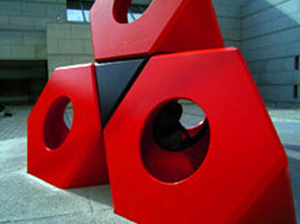3.19.25 — Modernism Inside-Out
Here it is, spring, so how about a glorious expedition? Starting fifty years ago, Isamu Noguchi pulled off a miracle. He turned a factory in Queens into a garden.
More precisely, it became the Noguchi Garden Museum and a tribute to one of Modernism’s greatest sculptors. Costco had not yet come to the neighborhood, where a piano factory a quarter mile north still held sway. A motel on Broadway looked none too inviting, and Socrates Sculpture Park on the waterfront was little more than an untended patch of green.  And still, with the museum’s opening in 1985, three years before its creator’s death, it brought a place for awakening and for peace. It has served ever since as a venue for Noguchi and more.
And still, with the museum’s opening in 1985, three years before its creator’s death, it brought a place for awakening and for peace. It has served ever since as a venue for Noguchi and more.
Can it look half as miraculous today? Approaching its fortieth anniversary, it attempts something almost as daring. To celebrate the occasion, it rehangs the collection—nineteen galleries plus an actual sculpture garden. Amy Hau, its director since January 2024, asks to compete with Noguchi himself. He purchased the building across from his Astoria studio and took pains with every inch. As sales of his work rose and fell, he needed a place for what had become his private collection, and he wanted it to look just right.
He built just three rooms from scratch and adapted the rest to his art. Even now one can marvel at how factory interiors look so open, how sculpture blends into the garden, and how both turn the space inside-out. The museum (since an earlier renovation, simply the Noguchi Museum) reopened on a sweltering Thursday before Labor Day, in 2024, as a relief from summer and the claustrophobic gallery season about to begin. It was a chance, too, to shine without special exhibitions. Past shows have included Saburo Hasegawa and Christian Boltanski, along with Noguchi’s hopes for a Memorial to the Atomic dead. Now it could reclaim the entire building for him alone.
Not everything has changed. His legacy may be daunting, but Noguchi was always an eager collaborator—on a Yale museum with Louis Kahn, the unfinished memorial to Hiroshima, city parks, and even a swimming pool. For him, play was indistinguishable from craft and art. And the rehanging is respectful enough, to the point that you may not notice a change. It may be a tad stricter in grouping sculpture by materials and forms. But then Noguchi can hardly help looking familiar whatever his survivors have done.
One enters to work from the 1970s, at his most memorable. Pockmarked surfaces bring out the weight of stone and give way to polished marble. As color enters, the lines of his sculpture turn on themselves without ever quite closing the circle. The second floor returns as ever to early work with more hints of figuration, including portrait busts, and gathers public projects. Allow me, then, to draw on to my first review of the Noguchi Museum, more than twenty years ago, next time for a fuller and to invite you to read more. Meanwhile I combine the present post with a past report on exhibitions ten years ago of Noguchi’s connections to calligraphy, costumes, and dance for a longer review and my latest upload.
A Whitney retrospective that very year could not carry the same punch. Pieces looked like nothing more or less than, well, works of art. Where Jacques Derrida spoke of an artwork’s frame as a supplement that undermines art’s claim to finality, at the Whitney a sculpture’s base appeared as just one more effort to remove a beautiful object from this world. Smaller rooms for his lamps looked like a brand-name designer’s section of a department store. At his own museum, Noguchi erodes the very distinction between an art object and its surroundings. He sets his work free to enter the world.
Read more, now in a feature-length article on this site.